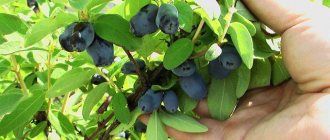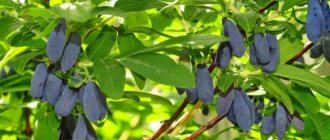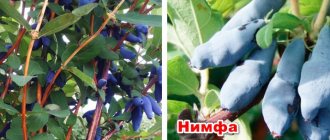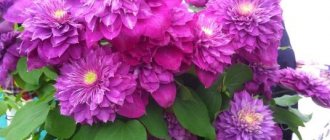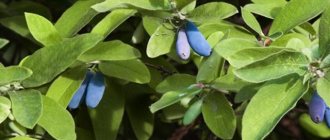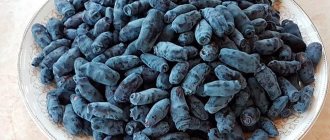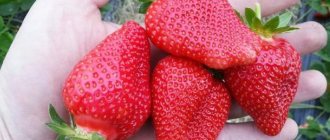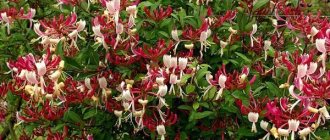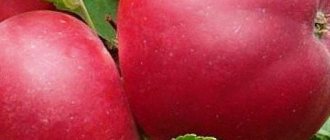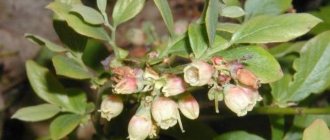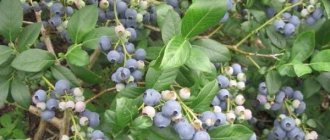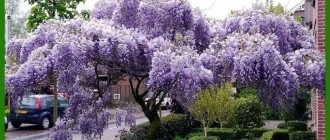Description of the variety
Honeysuckle Pride of Bakchar
Thälmann's honeysuckle is creeping and climbs very well. The evergreen vine grows up to 6 meters in height. The leaves are round, up to 10 cm long, uneven in color. The flowering of this species is unusual. In the inflorescence, 6-7 flowers of golden-orange color are formed. The plant produces round fruits. The growing season for orange honeysuckle lasts from the beginning of spring until frost.
Thälmann's honeysuckle will help hide noticeable imperfections in the landscape of your site
Thälmann's honeysuckle has a high yield. Up to 1.5 kg of ripe berries are harvested from one bush. But the frost resistance of the plant is average. In harsh climatic conditions, care must be taken to ensure timely and reliable protection of the bush.
Blooming honeysuckle can be used by landscape designers as a decorative element. For example, it can be used to cover an ugly wall of a building or an unaesthetic structure or fence. This flower is used for vertical gardening; it only needs to install supports along which it will weave. This design looks very original and stylish.
There are other types of flowering ornamental honeysuckle that have found effective use in landscape design. These include:
- Lonitser;
- Honeysuckle;
- Maigrun (shiny).
Thälmann's honeysuckle is an indispensable tool in the work of a landscape designer
Ideas for creating coziness in your area can be gleaned not only from dacha magazines, but also from the Internet, where each picture carries a sea of useful information. The pergola, entwined with decorative honeysuckle, looks great. Creeping honeysuckle will look no less original. The main thing is to find the right use for it.
Planting honeysuckle
The liana is demanding on soil and lighting. The soil must retain moisture well and be nutritious. The honeysuckle flower is planted in a well-lit place or in light partial shade. Summer temperature changes are not dangerous for this crop, but in winter it does not tolerate frost well. To increase its winter hardiness, it is recommended to make a shelter in the fall.
Honeysuckle Bakcharsky Giant
For those who have decided to grow Thälmann’s honeysuckle, planting and caring for it is interesting not only in theory, but also from the point of view of practical experience. Reviews from gardeners indicate that the plant definitely needs powerful supports and reinforcements. Lustrous honeysuckle, as it is sometimes called by summer residents, does not tolerate drought. In order to prevent the soil from drying out, it is advisable to mulch. Landscape design will look even better if you plant ground cover flowers under the vine, which will help retain moisture.
Attention! Decorative multi-colored wood chips are used as mulch in the summer. It is not only a decorative element, but also prevents the growth of weeds.
To plant orange honeysuckle, dig a hole 10 cm larger than the clod of earth located on the roots of the acquired seedling. If you plan to arrange a hedge, then leave a distance of 1.5 meters between the bushes. The soil is fertilized with compost, a small amount of sand and wood ash. Using litmus paper, determine the acidity level of the soil. If the pH value is less than 6.5-7, then slaked lime should be added.
Before planting Thälmann's honeysuckle, the soil must be carefully prepared.
Once all the preparatory work has been completed, the actual planting of the shrub begins. During planting, you must carefully handle the roots and try not to damage them. If a large seedling is planted, its lashes are immediately straightened along the supports. You should not use sawdust for mulching. Otherwise, they still need to be removed for the winter, otherwise they can trample and form a hotbed of fungal diseases.
Agricultural technology
It is better to plant honeysuckle in the fall, before the first frost. Autumn planting gives the plant the opportunity to get used to a new place and take root.
Did you know? In Rus', honeysuckle branches have long been used to produce whips, nails for shoemaking and cleaning rods.
Selecting a location
The plant is planted next to other low fruit bushes. Thus, the stems and roots will be shaded and protected from overheating. The distance of underground sources from the soil surface is preferably 2–2.5 m. The root system of the crop is deep and does not like waterlogging. Before planting, the area is dug up with the addition of 10 kg of humus or compost per m². If necessary, the soil is deoxidized with wood ash or lime.
The top of the bush should be illuminated most of the day.
Planting and care
Before planting, the root system is dipped in a fungicide (Baktofit, Fitosporin) or a slightly pink solution of potassium permanganate for disinfection for 15–20 minutes.
Process technology:
- Holes are dug 40x60 in size, at a distance of 1.5 m. (A pollinator is planted nearby).
- The extracted soil (top layer) is mixed with fertilizers: superphosphate (50 g) and potassium salt (40 g).
- From the nutrient part of the soil, a mound is poured at the bottom of the hole according to the size of the roots.
- Place the seedling, straightening the roots.
- Sprinkle with soil so that the root collar is at least 3 cm from the soil surface.
- The soil is crushed with your palms and compacted so that air pockets do not form.
- After planting, watering is carried out in several stages, spending 10 liters of water on the bush.
- To prevent moisture from evaporating, the tree trunk circle is mulched.
Watering is carried out with water separated from the impurities of the water supply. Water in parts, waiting until the first portion is absorbed. An adult plant needs up to 20 liters of water. Moisture is especially needed during flowering and fruiting. The frequency of watering can be adjusted according to the condition of the soil: if it has dried out to 40–50 cm in depth, it needs to be moistened.
In the first year, there is no need to fertilize the bush: everything you need is included in the planting hole and when digging the area. The next year, in the spring, mineral nitrogen fertilizer, for example urea (20 g/m²), is added to the soil. During the flowering period, you can apply foliar liquid feeding to the leaves with a solution of wood ash 200 g/10 l of water. During fruiting, 50 g of potassium salt and superphosphate are added to the tree trunk circle. Organic fertilizers can be applied in the 3rd year.
Important! It is necessary to regularly loosen and weed. Weeds thicken the planting, creating a risk of disease
Loosening promotes better absorption of moisture and nutrients, and respiration of roots.
Features of pollination
The variety is self-sterile with bisexual flowers. To obtain a harvest, Lapis Lazuli requires proximity to pollinators with similar ripening periods.
The following varieties are suitable for the plant:
- Vlada;
- Fire Opal;
- cubic zirconia
Disease and pest control
Lapis lazuli is resistant to fungal diseases, however, you need to know the control measures in case of infection. The biological preparation “Baktofit” is used against most fungal and bacterial diseases of garden plants. The advantage of the fungicide is that it can be used at all stages of the honeysuckle growing season, including before planting.
Application of the drug:
- To disinfect the roots - 1 ml/1 liter of water, soak for 15 minutes.
- For fungi (powdery mildew, septoria) - 20 ml/10 l of water, water the soil in the tree trunk circle.
- Rust, late blight - 20 ml / 10 l of water, spraying the bush.
Honeysuckle can be attacked by aphids and leaf-eating pests.
The broad-spectrum drug Actellik will help in the fight against insects and their larvae. For spraying plants, the working solution is prepared in the proportion of 2 ml/2 l of water.
Pruning and crown formation
Pruning for medium-sized honeysuckle is carried out in spring and autumn. The sanitary procedure includes the removal of frozen, broken, weak or diseased branches. It is carried out both in the spring, in April-May, and in the fall, before the onset of frost.
In spring, the bush needs to be shaped. In the first year, about 5 skeletal shoots are left, cutting out weak or inward-growing crowns. Further, every year after the inspection, the crown needs to be thinned, cutting out branches that are unpromising and thicken the bush. For the winter, broken shoots are removed so that during the winter the plant does not waste energy on their restoration.
Important! All work is carried out with sharpened, disinfected tools. Cuts must be treated with garden varnish to avoid infection.
Wintering
The Ural selection variety has high winter hardiness. It is not covered for the winter, and no other kind of preparation is carried out, except for autumn pruning.
Features of honeysuckle care
How to prune honeysuckle in spring
Caring for Thälmann's honeysuckle is easy. The main thing is to water it as the top layer of soil dries out. If the soil is mulched, the moisture is retained for a long time. Weeds are regularly removed, which not only draw nutrients from the soil, but also do not in any way color the elegant liana with their appearance. As the honeysuckle lashes grow, they spread evenly over the entire support, and the bush is molded.
During strong winds, the plant can fall to the ground, so it is better to use twine to securely fix it. Blooming honeysuckle is fed no more than 3 times during the entire season. Fertilizers are applied for the first time 14 days after planting on the garden bed, and then 21 days later. Complex mineral fertilizers are used for these purposes. In order for the vine to bloom faster, the emphasis should be placed not on nitrogen-containing fertilizers, but on potassium-phosphorus ones.
With proper care, Thälmann's Honeysuckle will certainly delight you with abundant flowering
If the summer turns out to be rainy and damp, then you need to worry about rotting of the root system. In this case, the mulch is removed, the flowerbed is thoroughly ventilated, and the soil is very carefully loosened. When carrying out these procedures, one must not allow damage to the root system, because the description says that in this variety it is located almost on the surface of the earth.
Agricultural technology
Due to the fact that Shapochnaya honeysuckle buds bloom very quickly in the spring, it is recommended to plant it in the fall. Agrotechnical measures consist of correctly selected growing location, watering, fertilizing, pest and disease control.
Did you know? One of the varieties of honeysuckle is wolfberry.
Selecting a location
The planting site plays an important role for the further growth of Shapochnaya honeysuckle. To achieve the greatest effect, it must meet the following requirements:
- the soil must be well permeable to moisture and have alkaline or neutral acidity;
- loamy soil is preferable;
- the place should be on the sunny side or in partial shade;
- do not plant on a hill, avoiding gusts of wind and drafts, which can significantly injure the plant and spoil its appearance.
Planting and care
Planting and caring for Shapochnaya honeysuckle is not particularly difficult. It is necessary to follow several tips to guarantee excellent results and good survival of the bush. They are as follows:
- Before planting, the area must be cleared of weeds and other debris.
- Dig holes in advance at a distance of 2 m from each other with a depth and width of 40 cm.
- Mix chernozem with 1 bucket of humus, add 1 tbsp. wood ash and 2 tbsp. l. superphosphate.
- Pour the nutrient mixture into the hole in a heap.
- Place the seedling vertically on the formed tubercle, straighten the roots, sprinkle with earth, and compact it.
- Pour water and mulch the tree trunk area (peat, sawdust).
After this, it is necessary to regularly pour 10–15 liters of warm, settled water under each bush until it takes root. It is advisable to water in the early morning or evening. In addition to watering, it is necessary to loosen the soil, trying to do it shallowly, since the roots of adult plants rise to the surface of the earth over time. For bushes 5–6 years old, it is recommended to cover the soil with mulch.
Important! In acidic soil, it is necessary to add lime, chalk or dolomite flour every 3 years to reduce acidity. The first fertilizing can be carried out 2 years after planting
To do this in the spring, before the buds open, you need to add 25–30 g of ammonium nitrate under each bush. In summer (July) it is necessary to fertilize with organic fertilizers (1 bucket per 1 m² of land). In autumn you should sprinkle 1-2 tbsp. wood ash and 20 g double superphosphate
The first fertilizing can be done 2 years after planting. To do this in the spring, before the buds open, you need to add 25–30 g of ammonium nitrate under each bush. In summer (July) it is necessary to fertilize with organic fertilizers (1 bucket per 1 m² of land). In autumn you should sprinkle 1-2 tbsp. wood ash and 20 g of double superphosphate.
Disease and pest control
Despite the fact that Shapochnaya honeysuckle is not often exposed to diseases or pest invasions, under unfavorable climatic conditions (high humidity, cold summers) fungal infections and viruses, such as powdery mildew, rust, and mesh mosaic, still appear.
Video: honeysuckle diseases
Of the insects, the most harmful are aphids, leaf rollers, moths, and spider mites. To avoid their harmful effects, it is recommended to use drugs such as “Vectra” (2.7 ml per 10 liters of water), “Topaz” (10 ml per 10 liters of water), “Gamair” (2 tablets per 1 liter of water), “Inta-vir” (1 tablet per 10 liters of water), “Fitoverm” (2 ml per 250 ml of water), “Aktara” (1 g per 10 liters of water), etc.
Pruning and shaping the bush
Another important process in growing Shapochnaya honeysuckle is pruning the bush and forming the crown. Sanitary pruning can be carried out in the second year after planting. To do this, you need to remove all dry and damaged branches, and treat the cut areas with garden varnish. Anti-aging pruning and crown formation are carried out in the 5th–6th year of the plant’s life.
It consists in clearing the root shoots, removing 1-2 old shoots every year, and not cutting off young branches. At the age of 15, you need to make a rejuvenating haircut, cutting out all the stems and leaving only 30–40 cm from the ground. In 3 years the plant will fully recover.
Wintering
The honeysuckle variety Shapochnaya can withstand frosts down to -23°C. In colder regions, the bushes of ornamental plants must be covered with covering material for the winter, and additionally covered with snow in winter for a better effect.
Did you know? Honeysuckle wood is very durable, so it was once used to make shoe nails and rake teeth.
If you adhere to the above advice from experienced gardeners, then you can safely grow the Shapochnaya honeysuckle variety on your site. It will delight its owners with a beautiful view, and will also serve as an excellent decor when creating landscapes, flower beds and other flower beds.
Honeysuckle propagation
Liana propagation is quite simple. Around mid-July, several branches are pressed to the ground and sprinkled with earth on top. This place is slightly moistened and mulched. As soon as the branches take root, they can be separated from the mother plant and planted in a new place.
There is another method of reproduction. You should cut a small shoot about 20 cm long and place it in water. As soon as roots appear on it, the shoot is planted in a previously prepared area.
If necessary, the young plant can be planted in a pot and kept in the apartment until spring. This is done in cases where, when planted in open ground, the seedling does not have time to take root before the onset of persistent cold weather.
Pests and diseases
Climbing honeysuckle is a shrub resistant to diseases and harmful insects. But sometimes garden honeysuckle can be attacked by the cabbage cutworm.
Cabbage scoop
This blackish-brown butterfly, with a body length of approximately 2 cm, can lay up to 200 eggs on the underside of leaves, from which thick caterpillars of dark green, brown or gray color hatch. With three light lines on the back and yellow side stripes. During the day, the caterpillars hide from the sun, and at night they eat honeysuckle leaves. To get rid of the pest, at the end of July the plants are sprayed with insecticides.
Spider mite
Small insects that suck the juice from young shoots and leaves entangle the bushes with cobwebs. Pests have a yellowish or reddish body and four pairs of legs.
Leaves affected by insects become covered with white spots, dry out and fall off, and the plant withers.
To get rid of mites, I treat the plantings with acaricides.
Honeysuckle aphid
A small insect of light green color, it feeds on the juice of young leaves. Leaves infected with aphids curl, turn yellow and dry out. Photosynthesis processes are disrupted, the plant does not receive enough nutrients, begins to bloom worse, and loses its decorative appearance.
To combat the pest, the tops where the colonies have settled are cut off and burned. Honeysuckle is sprayed with Fitoverm, Actellik.
Tip aphids attack the tops of plants
The honeysuckle barbel is a rather large beetle, with a body length of 2 cm, brown-yellow in color, with black wings. Lays eggs, from which whitish-yellow larvae hatch. They live in shoots, eating them from the inside. Adults gnaw leaf blades.
To combat the beetle, the shoots in which the larvae have settled are cut off and burned. Bushes for prevention are treated with Fufanon in the spring. The beetles are assembled by hand.
Decorative climbing honeysuckle can be affected by the following diseases.
Leaf rust
It appears as dark brownish swellings, resembling rust in color, on the surface of the leaf plates. Soon they burst, releasing spores of the fungus that causes the disease. To combat infection, branches with affected leaves are pruned and burned; in the spring, plantings are sprayed with copper oxychloride or Bordeaux mixture.
Decorating the site with honeysuckle
Everyone who has their own home is constantly thinking about how to decorate not only it, but also the surrounding area. A drawing in a magazine may give a good idea, but in practice it is much more difficult to implement. But honeysuckle is a win-win option for even the most capricious decorator.
After wintering, frozen branches of Thälmann's honeysuckle are quickly reanimated
The Telman variety, in comparison with Honeysuckle Honeysuckle, exhibits less frost resistance. During the winter, some branches may freeze, but with the onset of warmth they are quickly reanimated. The shrub is of greatest interest in June. Orange decorative Thälmann honeysuckle blooms for 2 weeks and looks luxurious. By the way, the fruits of this variety are also orange, and they ripen in September. The leaves that are bluish below and bright green above add additional charm.
